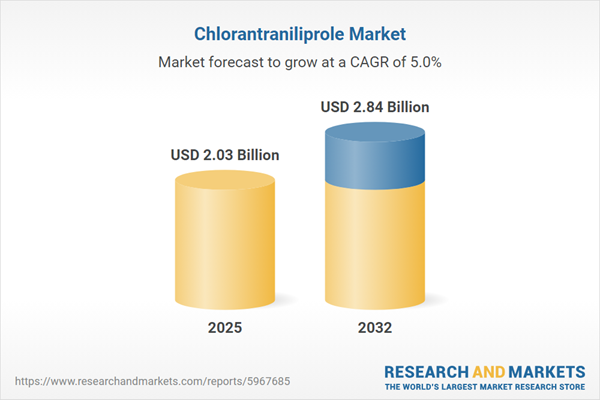Speak directly to the analyst to clarify any post sales queries you may have.
The chlorantraniliprole market is advancing as organizations pursue effective pest management aligned with sustainability mandates. Senior decision-makers are prioritizing adaptability and regulatory compliance, making chlorantraniliprole essential for resilient agricultural portfolios.
Market Snapshot: Chlorantraniliprole Market Trends and Growth
The chlorantraniliprole market is reporting notable growth, fueled by rapid adoption of advanced pest control approaches and a stronger commitment to sustainable agriculture. Expansion is evident across the sector, from global agri-corporations to smaller farming operations striving to meet stringent standards. Chlorantraniliprole’s inherent adaptability makes it beneficial for organizations seeking to diversify crop protection methods and remain agile amid changing environmental and operational frameworks. Industry leaders are extensively updating compliance systems and embedding this active ingredient within holistic integrated crop protection strategies. Growing environmental stewardship expectations continue to shape procurement and operational decisions across the agricultural value chain.
Scope & Segmentation: Chlorantraniliprole Market Coverage
- Crop Types: Chlorantraniliprole provides targeted pest control across major field crops like corn, specialty crops such as citrus, berries, leafy greens, oilseeds, pulses, and a diverse spectrum of fruits and vegetables. This adaptability enables regional and operational customization.
- Formulation Types: Available as emulsifiable concentrates, wettable granules, and suspension concentrates, each formulation type is designed to support specific climate and regulatory conditions while maximizing application flexibility and compliance.
- Application Methods: Solutions include foliar sprays, soil treatments, and seed coatings, giving organizations precise seasonal or year-round deployment options for both large-scale and smallholder operations.
- End User Segments: Utilized by large agribusinesses, greenhouse producers focused on precision, as well as smaller farms, supporting consistent compliance and sustainability improvements throughout supply networks.
- Mode of Action: Selective impact on pest ryanodine receptors facilitates robust resistance management, making chlorantraniliprole integral to sustainable crop protection programs.
- Geographical Regions: Adopted across the Americas, Europe, Middle East, Africa, and Asia-Pacific, with significant use in the United States, Brazil, Canada, China, India, Japan, Australia, South Korea, and growing adoption in emerging Latin American countries. Regional customization maximizes efficacy in diverse regulatory and agro-ecological settings.
- Key Players: Market development is led by companies such as Corteva Agriscience, Syngenta AG, FMC Corporation, BASF SE, ADAMA Agricultural Solutions, Sumitomo Chemical, UPL Limited, Rotam Agrochemical, Tagros Chemicals India, and ISK Biosciences, who are consistently investing in innovation.
Key Takeaways for Senior Decision-Makers
- Chlorantraniliprole enables enterprises to maintain alignment with stewardship best practices, ensuring structured, scalable compliance as regulatory demands evolve.
- Innovative formulation technologies, including microencapsulation and advanced polymer systems, improve both product safety and consistent field performance despite environmental variability.
- Deployment of digital agriculture tools, such as precision technology and drone-assisted applications, supports greater accuracy in pest management and enhances resource efficiency across varied cropping systems.
- Adaptable application options and comprehensive operational frameworks provide increased flexibility for proactive resistance management and facilitate timely response to shifting pest dynamics.
- Expanding supplier networks and adopting resilient sourcing strategies help organizations reduce potential impacts from global supply disruptions, supporting operational continuity.
Tariff Impact on Chlorantraniliprole Supply Chains
Recent tariff changes in the United States have complicated agrochemical sourcing, with senior decision-makers pursuing nearshoring, deeper supplier partnerships, and improved contract management to maintain steady supply chains. Coordinated collaboration between procurement and regulatory teams has become essential for uninterrupted access to chlorantraniliprole amid volatile trade environments.
Research Methodology & Data Sources
Analysis is based on structured interviews with specialists in agronomy, operations, engineering, and regulatory affairs representing key agricultural regions. Further perspectives are drawn from industry publications, sector forums, and scenario analysis, grounding all insights in current sector conditions and best practices.
Why This Report Matters
- Delivers actionable models for driving innovation and reinforcing compliance within a rapidly shifting competitive backdrop.
- Offers strategic guidance to fortify supply chain resilience and pre-emptively address unfolding operational or regulatory uncertainties.
- Links growth initiatives with compliance objectives, aiding organizations in pursuing responsible, sustained business advancement in crop protection.
Conclusion
Securing chlorantraniliprole within pest management strategies positions organizations to navigate evolving regulations and operational demands. Forward-thinking integration and cross-functional planning help industry leaders remain agile in the complex agricultural landscape.
Additional Product Information:
- Purchase of this report includes 1 year online access with quarterly updates.
- This report can be updated on request. Please contact our Customer Experience team using the Ask a Question widget on our website.
Table of Contents
3. Executive Summary
4. Market Overview
7. Cumulative Impact of Artificial Intelligence 2025
Companies Mentioned
The companies profiled in this Chlorantraniliprole market report include:- Corteva Agriscience, Inc.
- Syngenta AG
- FMC Corporation
- BASF SE
- ADAMA Agricultural Solutions Ltd.
- Sumitomo Chemical Co., Ltd.
- UPL Limited
- Rotam Agrochemical Company Limited
- Tagros Chemicals India Limited
- ISK Biosciences Corporation
Table Information
| Report Attribute | Details |
|---|---|
| No. of Pages | 198 |
| Published | November 2025 |
| Forecast Period | 2025 - 2032 |
| Estimated Market Value ( USD | $ 2.03 Billion |
| Forecasted Market Value ( USD | $ 2.84 Billion |
| Compound Annual Growth Rate | 4.9% |
| Regions Covered | Global |
| No. of Companies Mentioned | 11 |









